Bengali Moong Dal, also known as Bhaja Moong-er Daal, is a typical Bengali delicacy. A lot of Indian dal dishes can taste similar to each other, but this Bengali Moong Dal stands out from the -dal- crowd! If you love dal, you're in for a little surprise as this Bengali-style dal dish is packed with flavor and a lovely texture. The moong dal is gently roasted over a medium flame until it turns into a beautiful golden brown and is cooked al dente, as opposed to soft. As is common with many Bengali recipes, this rendition includes mustard oil, which creates a deeper, sultrier flavor, fit for special occasions.
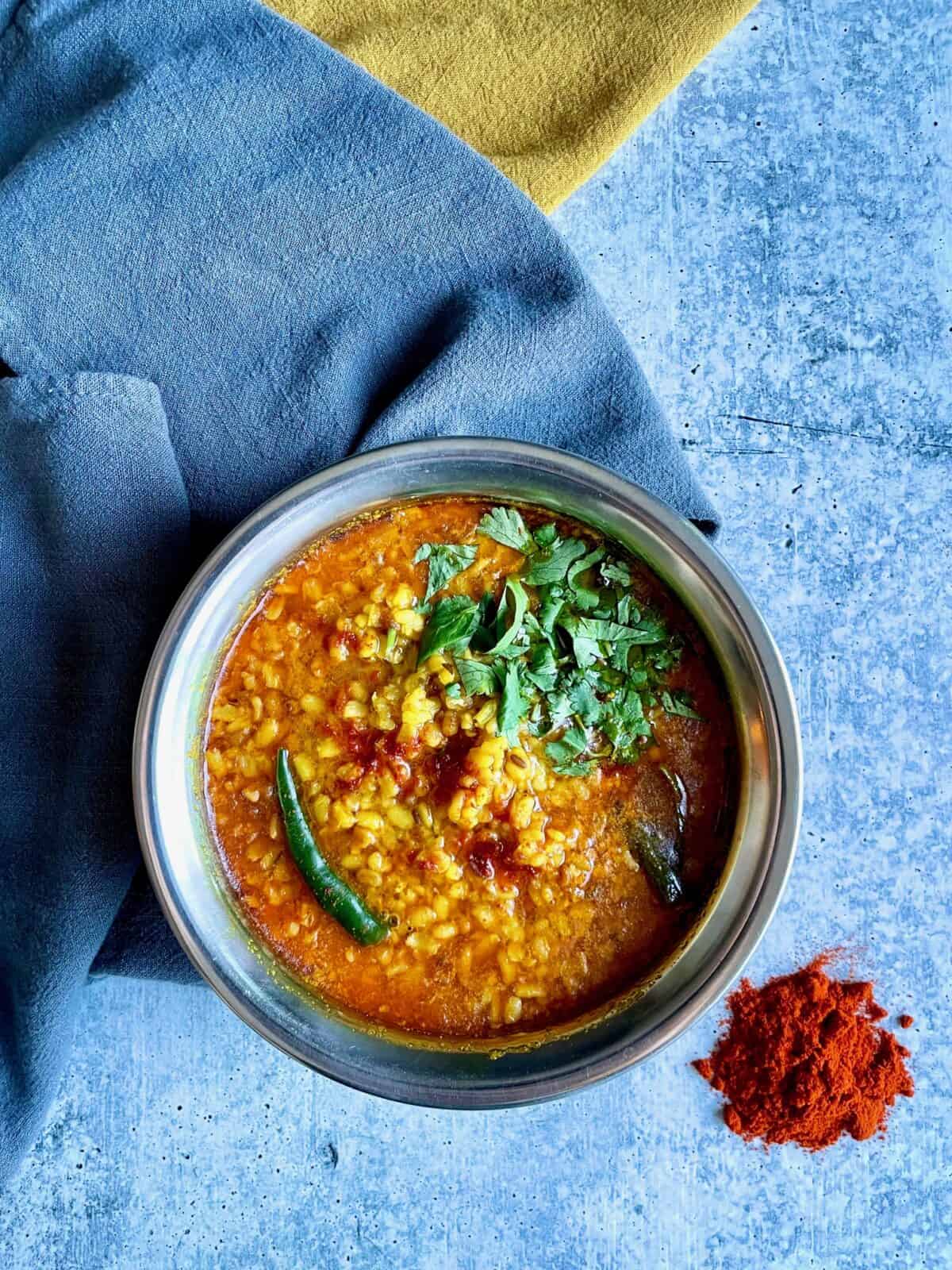
Jump to:
- What are dals?
- What makes moong dal special?
- Why you'll love this recipe
- How is Bengali Moong Dal different from other dal dishes?
- Recipe Ingredients
- How to make Bengali Moong Dal: Step by Step
- Sourcing specific ingredients
- Frequently Asked Questions
- Storage and heating
- Typical Bengali Moong Dal Recipe (with Mustard Oil)
- Related articles
What are dals?
First off, let's get some basics out of the way. Dal, in the ancient Indo-Aryan language Sanskrit, means to split. In Indian culture, dal is a simple umbrella term for pulses, lentils, beans, or peas of all shapes and sizes, and yes, that includes those that have been halved, meaning split. It is very common in India to find split pulses of all types. They are so convenient as they cook much faster.
What makes moong dal special?
Whole moong dal beans are native to India and belong to the legume family. Also known as mung beans, they are green and quite small. After the whole green moong dal beans have been skinned and split, they’re referred to as moong dal, and they somewhat resemble petite yellow lentils. See picture below. They cook fast, produce the most delightful velvety texture, and have a slightly sweet taste.
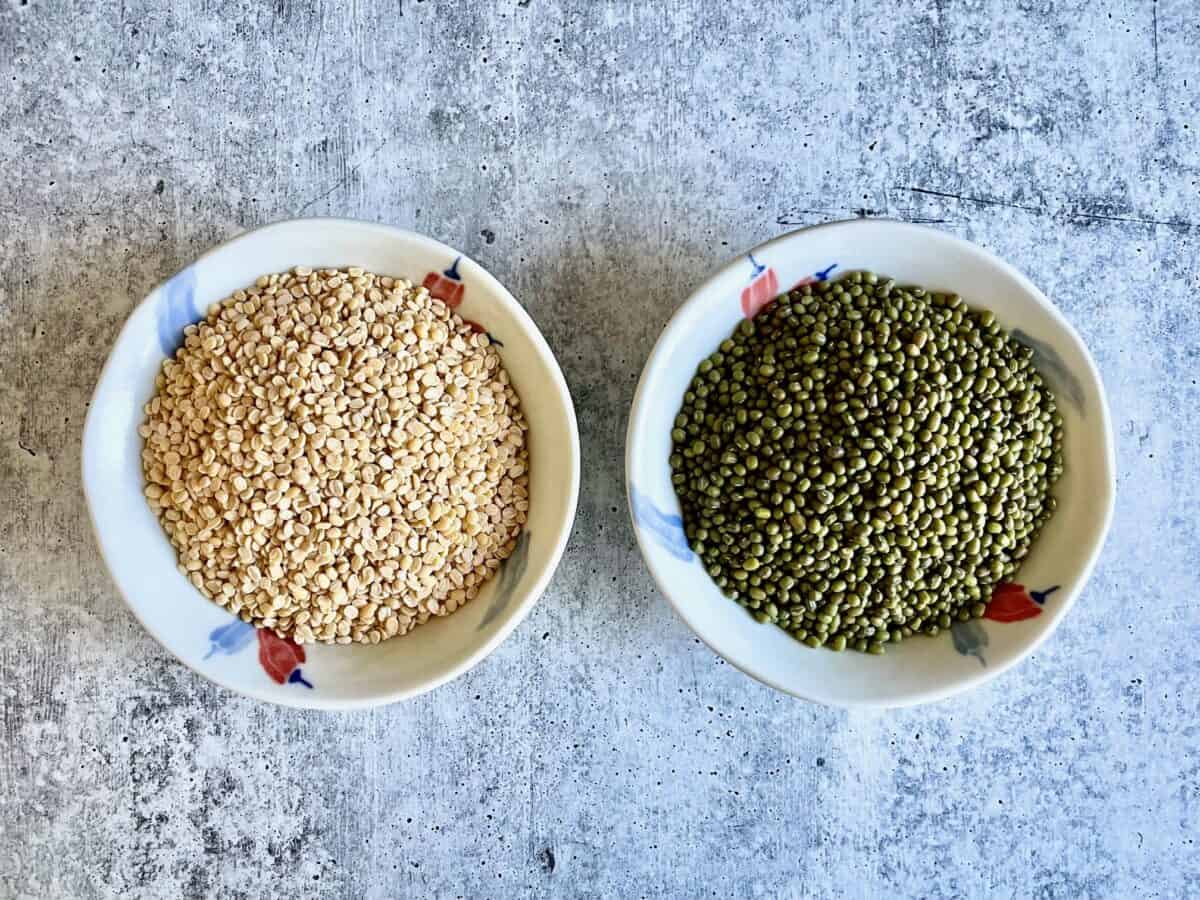
Left: Split moong dal
Right: Whole green moong dal before it's skinned and split.
Why you'll love this recipe
I aim to share nourishing recipes for busy but healthful foodies, and this Bengali Moong Dal boasts many health benefits that might make you fall in love with it! Below are the top reasons why I wanted to bring this to my readers:
Supports the digestive system. I love beans and pulses, but unfortunately, a few years ago, I couldn't digest them properly. Even the highly digestible yellow lentils (masoor dal) were causing me some trouble. Upon doing some research, I quickly learned that moong dal, my friends, is one of the most digestible pulses you'll ever enjoy. In fact, it is so easy to digest that it is one of the baby's first foods in India, especially in the Northern part. They have been my dal of choice ever since.
No garlic or onion. This recipe is excellent for people with extra sensitive digestion who cannot consume garlic or onion, as it doesn't contain any allium. There is, however, a little bit of hing added as its flavor profile is reminiscent of garlic. Hing, also known as asafoetida, is a potent flavor bomb, and it is commonly used in communities that do not use any allium for health or religious reasons.
Great if you cannot tolerate lactose. Many years ago, I upgraded my regular ghee to cultured ghee. Although regular ghee contains very low levels of lactose and is appropriate for people with dairy sensitivity, cultured ghee takes it a step further due to the way it is prepared.
If you'd like to read more whether ghee is ok for dairy allergy, please check out my ultimate guide. You might also enjoy reading about moong dal health benefits and side effects article that goes into detail about both.
Cultured ghee is made with fermented milk (read yogurt), and during the fermentation process, lactose is converted into lactic acid, which makes the cultured a much more desirable product for people with extreme dairy sensitivities. Read more about the difference between regular ghee and cultured ghee.
Helps regulate blood sugar. This is one of my favorite qualities about this dal as a few years ago, I was diagnosed as pre-diabetic. This means that I have to be careful with sugar spikes, and the food I consume needs to be high in fiber, low in carbs, and highly nutritious. If you're also watching your blood sugar, I'm happy to report that moong dal contains all those elements, which means that it slows the release of sugar into the bloodstream. A high fiber content also means feeling full for longer. Bonus!
Antioxidant and anti-inflammatory. Mustard oil is packed with omega-3 fatty acids, which have been known to help reduce inflammation in the body. The omega-6 in mustard oil helps reduce the risk of heart disease. Turmeric powder is another healing spice used in this recipe that is well-known for its incredible antioxidant and anti-inflammatory benefits.
One of my recent articles goes over the difference between yellow moong dal vs mung beans in further detail. I highly recommend having a look at it!
How is Bengali Moong Dal different from other dal dishes?
When it comes to West Bengal, people have strong opinions about incorporating mustard seed oil in their cookery. In fact, the average Bengali household doesn't skimp on this highly aromatic and delicate oil. During the times of the British occupation in India, a port in Kolkata (then Calcutta) shipped indentured laborers to other countries to work in sugar cane fields. One such country was my native country Mauritius. Due to many Indo-Mauritians tracing their lineage back there, Mauritius has some recipes that also use mustard seed oil for cooking. One such delicacy is the Mauritian Fish Vindaye, a beloved mustard-scented dish that all Mauritians are fond of.
Bengali Moong Dal is different from other types of dal dishes in the following ways:
The moong lentils are dry roasted on medium heat prior to adding them to water in a pot, unlike other dal preparations where you would skip that step. This is because we are not preparing a velvety dal dish, but a Bhaja Mooger Dal (its other name) where the dal keeps its shape, and does not become mushy. Bhaja refers to “fried” as the split moong dal is traditionally fried in mustard oil or ghee. This step imparts the dish with its distinctive nutty aroma. Although we are not frying it in mustard oil or ghee, my method of dry roasting the dal isn't unusual, and this method will not sacrifice the end result: a delicious comfort food fit for a West Bengal household.
The addition of the mustard seed oil also makes it uniquely Bengali, and this has already been addressed earlier. You can cook the lentils close to al dente or soft, you choose. I prefer to make it so that dal still retains its shape and doesn't loose its lovely texture. If you would prefer it soft, you can still cook it for longer, until you are happy with the texture.
To add sugar or not to add sugar?
Please note that it is quite common for a traditional Bengali dal recipe to contain sugar. I prefer to omit any added sweetener due to the dry roasted moong daal already being a bit sweet, and the omission of sugar makes the dish an even more wholesome meal. If you prefer a bit of sweetness to your dal but still want a healthier alternative to sugar, I recommend adding either half a teaspoon of neutral-tasting honey, coconut jaggery, or monk fruit. All of them will be less likely to spike your blood sugar than sugar would.
Recipe Ingredients
Split moong dal (or split mung dal)
Mustard oil
Ghee (I prefer to use cultured ghee)
Ginger paste
Green chilies
Cumin seeds, divided
Turmeric powder
Red chili powder
Hing, also called asafoetida (I prefer to use gluten-free hing), divided
Cilantro (or coriander leaves)
Salt

How to make Bengali Moong Dal: Step by Step
1. Heat a large pan, preferably cast iron, on low to medium flame.
2. Add the moong dal (no need to rinse first) to the pan and gently roast until it changes to a golden color, but not brown, and emits a nutty aroma. This takes about 5-6 minutes. Stir it every so often so that the dal roasts evenly. Set the roasted moong dal aside.

Picture: Dry-roasted moong dal in cast iron pan.
3. In a medium saucepan, bring 5 cups of water to a boil. Add roasted moong dal, and cook over medium to low flame until it is al dente, meaning until it's cooked through but still a bit hard in the middle. Takes about 10 minutes.
4. Meanwhile, heat the mustard oil in a medium stock pot over medium flame.
5. Once the oil is hot, add the 1 teaspoon cumin seeds and let it sizzle for about 30 seconds.
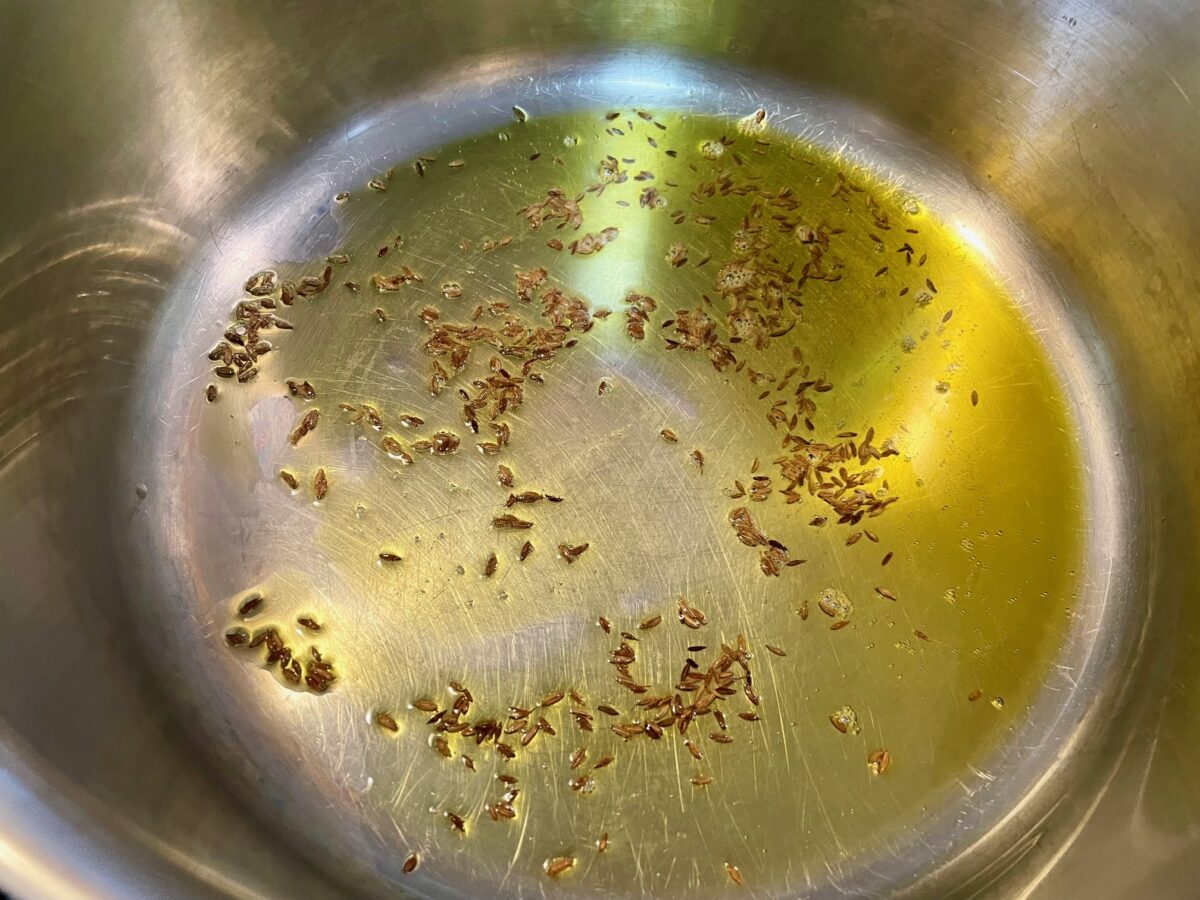
6. Next, add the green chilies and grated ginger; stir only to mix. Then add the rest of the spices: turmeric powder, red chili powder, a pinch of hing, and salt.
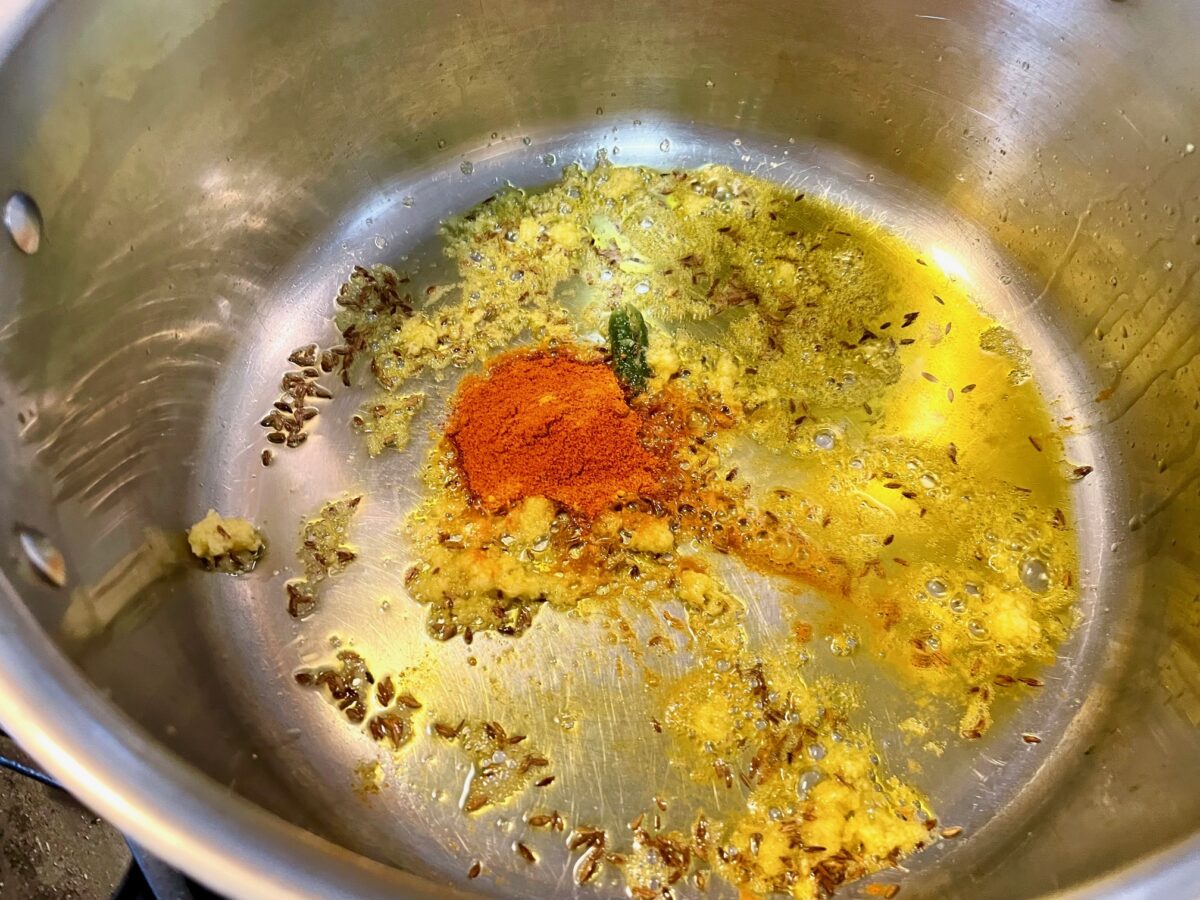
7. Once your dal is ready, pour it into the cooked spices and cook for another 10 minutes.
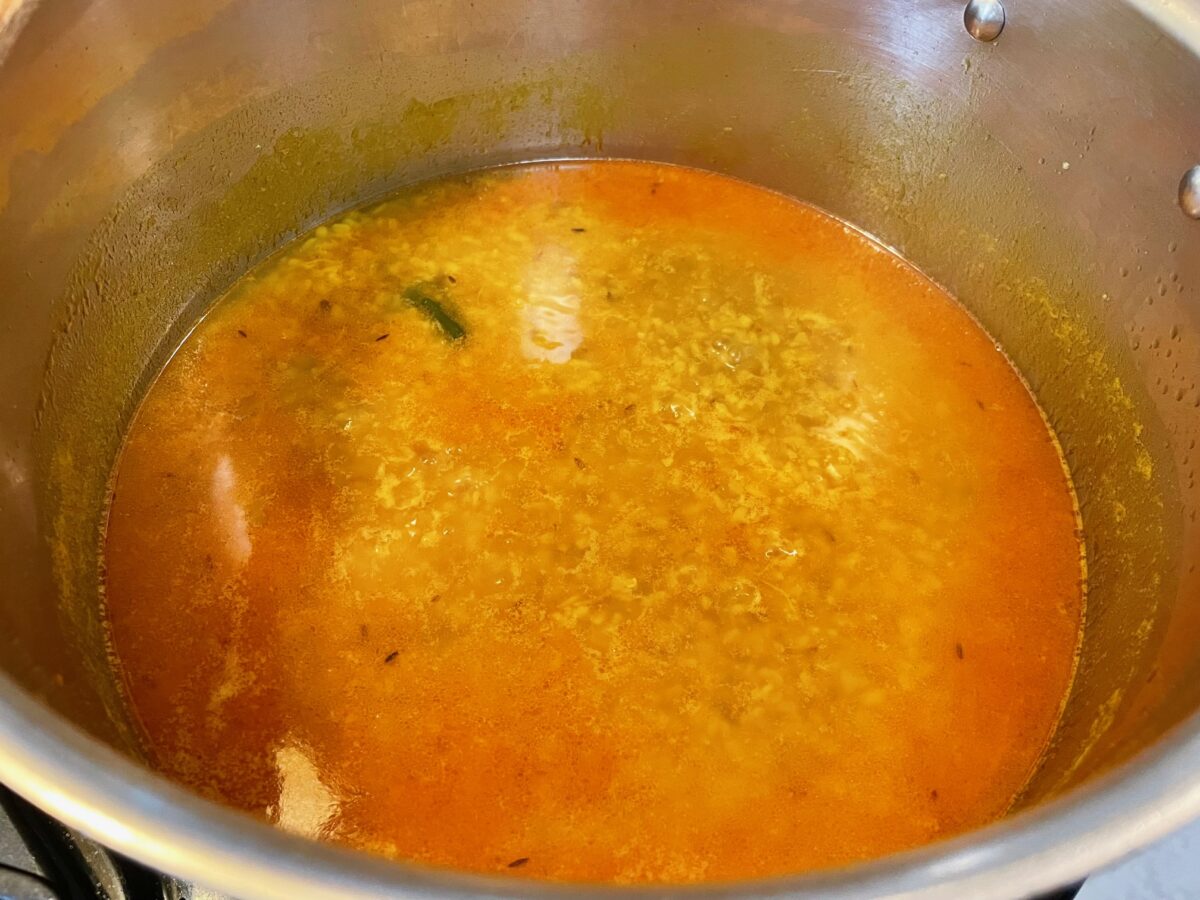
8. Taste your dal and adjust the salt to your liking.
9. Tempering. In a tempering pan (also known as tadka pan), or any small saucepan if you don't own one, heat 1 tablespoon of ghee over medium heat. Add 1/2 teaspoon of cumin seeds along with a pinch of hing. Cook until the beautiful aroma of the cumin seeds fills the room, about 30-45 seconds. Pour your tempered spices and ghee into the dal and mix well.
10. Garnish with fresh cilantro and serve with steamed basmati rice.
Sourcing specific ingredients
If you're here, it probably means that, like me, you're a stickler for high-quality products and prefer to source from companies with true values. For me, quality doesn't mean just organic, it also means it's pure and free of preservatives, unnecessary chemicals, and the products went through some rigid quality control, including testing.
You can find some of these products from your local Indian grocery store but they might not have organic versions or source from Fair Trade Farmers.
Here are my favorite sources for some of the products used in this recipe. I love the convenience of shopping online and supporting small companies doing a lot of good like Pure Indian Foods.
Certified organic mustard seed oil
Grass-fed and organic cultured ghee
Gluten-free hing
Organic moong dal
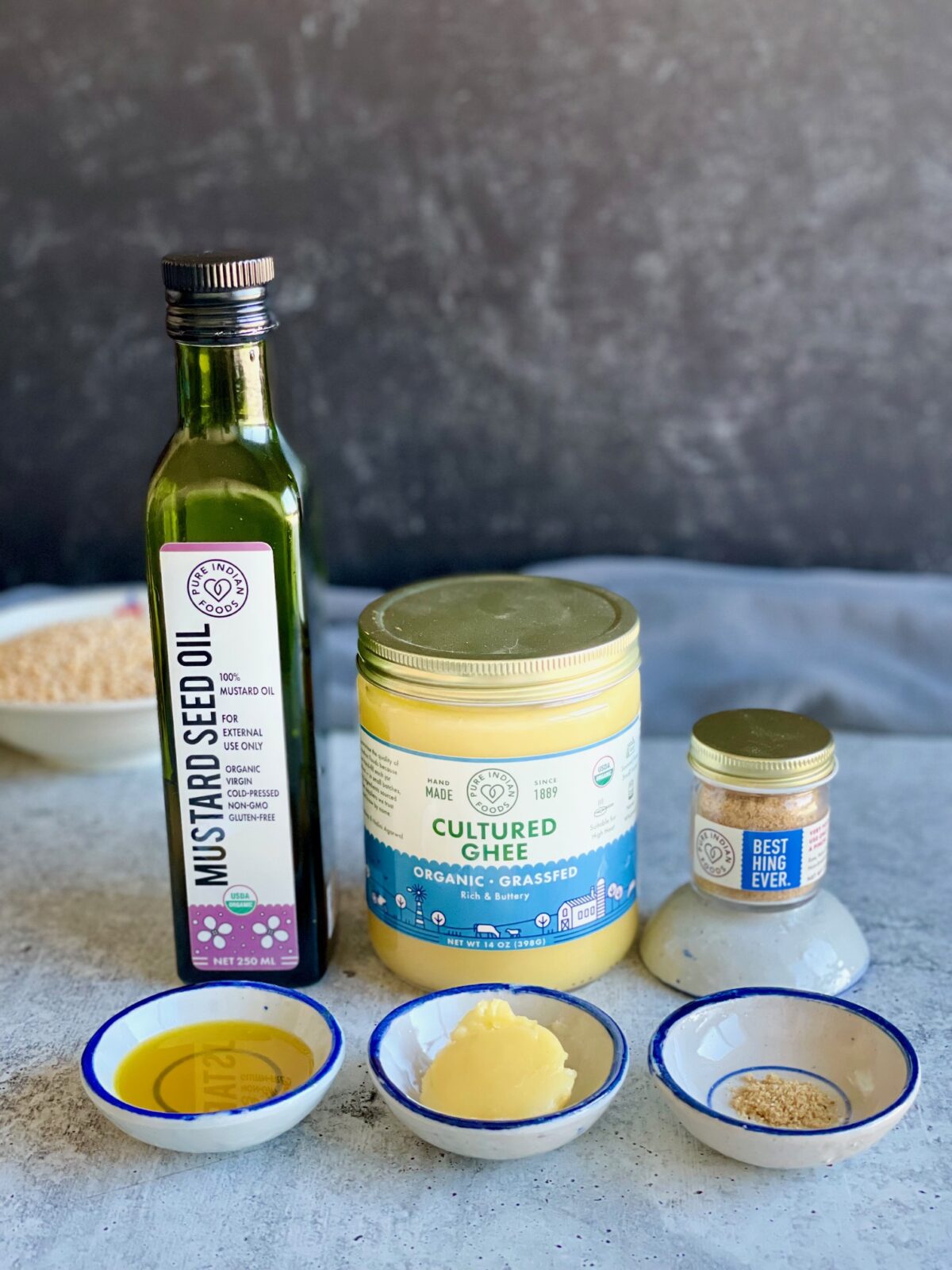
Frequently Asked Questions
Make it a vegetable dal! You can incorporate some veggies in the mix; the most common ones for this bhaja moong dal are green peas or any winter vegetables like cauliflower florets. Make sure you cut them small, around an inch in size, as they will cook quicker that way. You might need to add one or two more cups of water to make sure you have enough water to cook the dal and the veggies.
You can make it as per the recipe the first time and adjust the recipe to your liking later. But if you are a pretty adventurous cook or very confident in the kitchen, you can incorporate these commonly used ingredients:
Whole spices like green cardamom, fennel seeds, whole red chilis, and Indian bay leaf.
Ground spices like garam masala powder or some panch phoron (which is basically an Indian five-spice).
An acidic element like lime, key lime, or lemon juice.
Garlic. This recipe doesn't contain garlic, but if you love garlic, you can add a teaspoon of grated garlic or some garlic powder.
Grated coconut. Coconut goes really well in this dish. Add 1 tablespoon of grated coconut to the tempering oil at the same time you add the cumin.
What other dal can I use? I wouldn't really recommend other types of dals primarily because all the other ones will become too foamy when you simmer them. You should be able to find moong dal in all Indian grocery stores, and if you don't have any close to you, you can always find them on Amazon.
Mustard oil and ghee. If you cannot find mustard oil, you can use vegetable oil instead.
Cilantro
If you don't like cilantro, you can omit it.
Yes, make it plant-based by replacing the ghee with more mustard oil, or a combination of the latter and vegetable oil.
Storage and heating
Transfer leftovers to glass containers. Let the dish completely cool down before storing it in the fridge. It will keep in the fridge for at least four days and taste even better the next day!
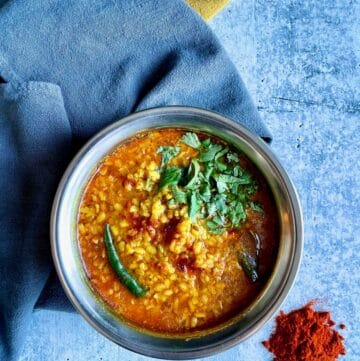
Typical Bengali Moong Dal Recipe (with Mustard Oil)
Ingredients
- 1 cup split moong dal also called split mung beans
- 3 tablespoon mustard oil or vegetable oil
- 1½ teaspoons cumin seeds divided
- 1 green chili slit
- 1 tablespoon ginger grated
- 1 teaspoon turmeric powder
- 1 teaspoon Kashmiri chili powder or any red chili powder
- 2 pinches gluten-free hing or regular hing (also called asafoetida), divided
- 1 teaspoon salt
- 1 tablespoon cultured ghee or regular ghee
Instructions
Roast the moong dal
- Heat a large pan, preferably cast iron, on low to medium flame.
- Add the moong dal (no need to rinse first) to the pan and gently roast until it changes to a golden color, but not brown, and emits a nutty aroma. This takes about 5-6 minutes. Stir it every so often so that the dal roasts evenly. Set the roasted moong dal aside.
Boil the roasted moong dal
- In a medium saucepan, bring 5 cups of water to a boil. Add roasted moong dal, and cook over medium to low flame until it is al dente, meaning until it's cooked through but still a bit hard in the middle. Takes about 10 minutes.
Cook the spices
- Meanwhile, heat the mustard oil in a medium stock pot over medium flame.
- Once the oil is hot, add the 1 teaspoon cumin seeds and let it sizzle for about 30 seconds.
- Next, add the green chilies and grated ginger; stir only to mix. Then add the rest of the spices: turmeric powder, red chili powder, a pinch of hing, and salt.
- Once your dal is ready, pour it into the cooked spices and let simmer on medium flame for another 10 minutes.
- Taste your dal. Adjust the salt to your liking.
Tempering
- In a tempering pan (also known as tadka pan), or any small saucepan if you don't own one, heat 1 tablespoon of ghee over medium to low heat. Add 1/2 teaspoon of cumin seeds along with a pinch of hing.
- Cook until the beautiful aroma of the cumin seeds and hing fills the room, about 30-45 seconds. Pour the tempered spices and ghee into the dal and mix well. Taste the dal again and adjust salt level accordingly.
Serve
- Garnish with fresh cilantro and serve with steamed basmati rice.
Related articles
If you'd like to learn more about this nutrition-packed yellow lentil and discover some of its potential side effects, you might enjoy my moong dal benefits and side effects article that goes into much greater detail about its pros and cons.
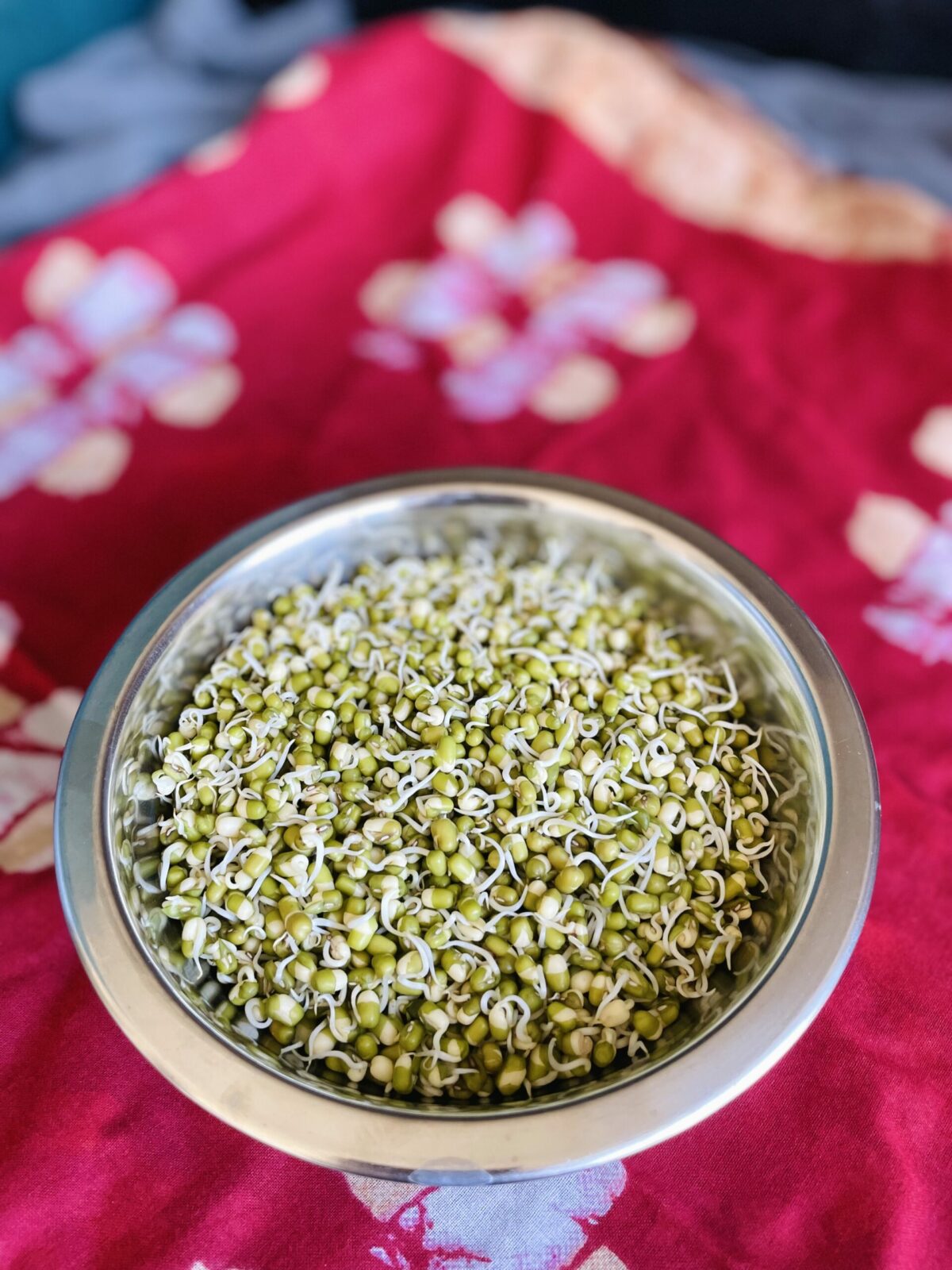
Please leave me a comment if you have any questions and just want to say "hi." I would love to hear from you!


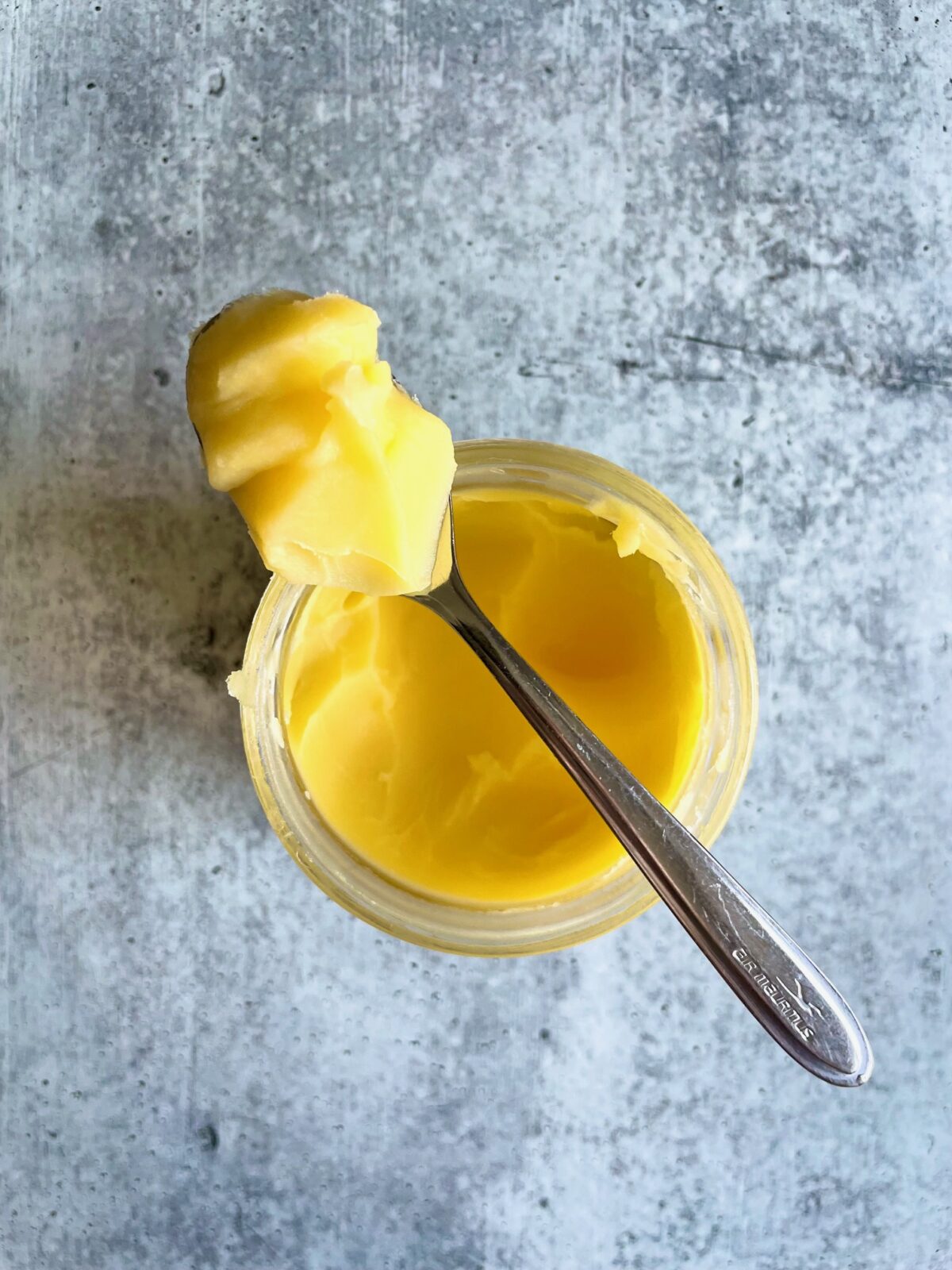
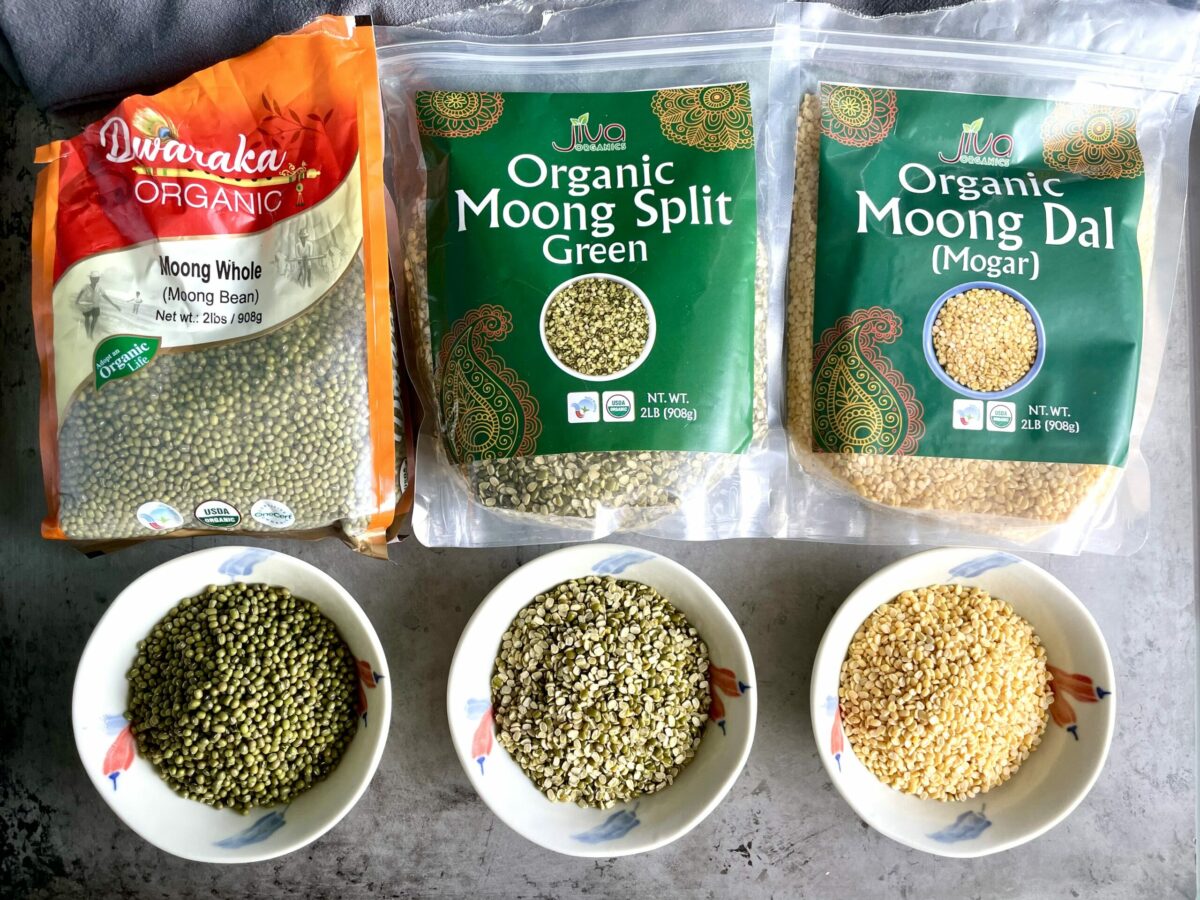
Leave a Reply